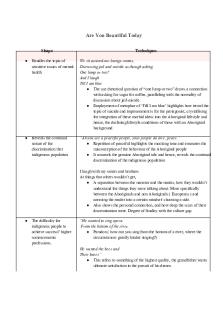Good morning ladies and gentlemen, thank you all for coming here today PDF

| Title | Good morning ladies and gentlemen, thank you all for coming here today |
|---|---|
| Course | Inglés Iv |
| Institution | Universidad Nacional de La Matanza |
| Pages | 3 |
| File Size | 69.5 KB |
| File Type | |
| Total Downloads | 58 |
| Total Views | 110 |
Summary
Download Good morning ladies and gentlemen, thank you all for coming here today PDF
Description
Good morning ladies and gentlemen, thank you all for coming here today. My name is…………. and I am an Electronics engineer. The topic of my presentation is about robotics and its impact on the world. This topic is very important for you because by the end of this talk, you will be familiar with concepts such as robotics, robotic aspects and applications. I’ve divided my presentation into three parts: ● I’ll start off by defining robotics and I’ll explain its importance. ● Then, I’ll move on to point out the basic similarities when it comes to their construction. ● Finally, I’ll end with a mention of the applications. My talk should take about 5/10 minutes, and then we’ll have time for questions. To begin with, I’d like to give a definition of robotics. Robotics is the branch of mechanical engineering, electrical engineering and computer science that deals with the design, construction, operation, and application of robots, as well as computer systems for their control, sensory feedback, and information processing. These technologies deal with automated machines (robots for short) that can take the place of humans in dangerous environments or manufacturing processes, or resemble humans in appearance, behaviour, and or cognition. It is very important because robotics is a rapidly growing field, as technological advances continue; researching, designing, and building new robots serve various practical purposes, whether domestically, commercially, or militarily. Many robots are built to do jobs that are unsafe to people such as defusing bombs, finding survivors in unstable ruins, and exploring mines. That’s all I have to say about robotics. This leads me to my next point, which is about the basic similarities when it comes to their construction. 1. Robots all have some kind of mechanical construction, a frame, form or shape
designed to achieve a particular task. The mechanical aspect is mostly the creator's solution to completing the assigned task and dealing with the physics of the environment around it. 2. Robots have electrical components which power and control the machinery. For
example, the petrol-powered machines that get their power mainly from petrol still require an electric current to start the combustion process which is why most petrol-powered machines like cars, have batteries. The electrical aspect of robots is used for movement, sensing and operation.
3. All robots contain some level of computer programming code. A program is
how a robot decides when or how to do something. There are three different types of robotic programs: remote control, artificial intelligence and hybrid. A robot with remote control programing has a preexisting set of commands that it will only perform if and when it receives a signal from a control source, typically a human being with a remote control. Robots that use artificial intelligence interact with their environment on their own without a control source, and can determine reactions to objects and problems they encounter using their preexisting programming. Hybrid is a form of programming that incorporates both AI and RC functions.
That brings us to my last point, the applications of robots. Many robots are designed for assembly work, which may not be readily adaptable for other applications. They are named as "assembly robots". For seam welding, some suppliers provide complete welding systems with the robot that is the welding equipment along with other material handling facilities like turntables, as an integrated unit. Such an integrated robotic system is called a "welding robot" even though its discrete manipulator unit could be adapted to a variety of tasks. Some robots are specifically designed for heavy load manipulation, and are labelled as "heavy duty robots". Other current and potential applications include: ● Military robots ● Robots such as HOSPI [4] are used as couriers in hospitals (hospital robot). Other hospital tasks performed by robots are receptionists, guides and porters helpers. ● Robots can serve as waiters and cooks., also at home. ● Robot combat for sport – hobby or sport event where two or more robots fight in an arena to disable each other. ● Cleanup of contaminated areas, such as toxic waste or nuclear facilities. ● Agricultural robots ● And medical robots performing low-invasive surgery.
Ok, that brings me to the end of my presentation. To summarize, the main points were the importance of robotics that are used in many different environments and for many different uses since military robots to robots that can serve as waiters or cooks. In my opinion, I believe that this is due to technological advances, sharing ideas and transnational corporations seeking to innovate in different fields, or in other words, due to globalization...
Similar Free PDFs

Thank You for Smoking Paper
- 5 Pages

Assignment MGT162 - THANK YOU
- 16 Pages

Position Paper - Thank you
- 2 Pages

Active file - thank you
- 1 Pages

Good morning students - HIST 395
- 2 Pages

MCQ-102-OB - thank you
- 27 Pages

Thank You Cards
- 3 Pages

Phase 1 - Thank you
- 28 Pages

Are you beautiful today
- 3 Pages

2.1 -2 - no thank you
- 3 Pages
Popular Institutions
- Tinajero National High School - Annex
- Politeknik Caltex Riau
- Yokohama City University
- SGT University
- University of Al-Qadisiyah
- Divine Word College of Vigan
- Techniek College Rotterdam
- Universidade de Santiago
- Universiti Teknologi MARA Cawangan Johor Kampus Pasir Gudang
- Poltekkes Kemenkes Yogyakarta
- Baguio City National High School
- Colegio san marcos
- preparatoria uno
- Centro de Bachillerato Tecnológico Industrial y de Servicios No. 107
- Dalian Maritime University
- Quang Trung Secondary School
- Colegio Tecnológico en Informática
- Corporación Regional de Educación Superior
- Grupo CEDVA
- Dar Al Uloom University
- Centro de Estudios Preuniversitarios de la Universidad Nacional de Ingeniería
- 上智大学
- Aakash International School, Nuna Majara
- San Felipe Neri Catholic School
- Kang Chiao International School - New Taipei City
- Misamis Occidental National High School
- Institución Educativa Escuela Normal Juan Ladrilleros
- Kolehiyo ng Pantukan
- Batanes State College
- Instituto Continental
- Sekolah Menengah Kejuruan Kesehatan Kaltara (Tarakan)
- Colegio de La Inmaculada Concepcion - Cebu





